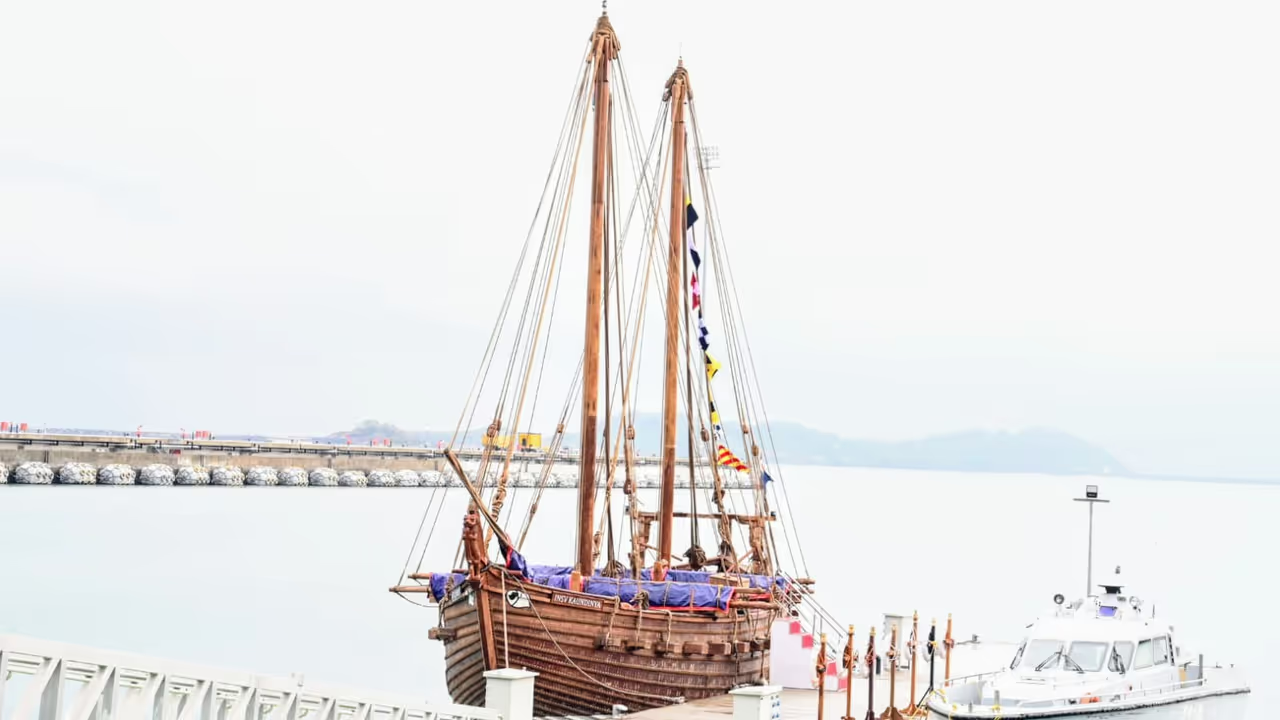INSV Kaundinya, a traditionally stitched sail ship inspired by ancient Indian maritime heritage, was commissioned by the Indian Navy to honour legendary mariner Kaundinya and revive historical seafaring traditions.
New Delhi: The Indian Navy has formally commissioned a traditional stitched sail ship, named INSV Kaundinya, at its Karwar naval base in Karnataka. The ceremony took place on Wednesday in the presence of Union Culture Minister Gajendra Singh Shekhawat.

Inspired by a 5th-century CE vessel depicted in the murals of the Ajanta Caves, INSV Kaundinya stands as a tribute to India’s ancient maritime and shipbuilding heritage. The project was initiated through a tripartite agreement signed in July 2023 between the Ministry of Culture, the Indian Navy, and Hodi Innovations.
Master shipwright Babu Sankaran and his team of skilled artisans from Kerala used traditional method of stitching to construct INSV Kaundinya and launched it in February this year at Goa.
Who Was Kaundinya? Legendary Mariner Behind INSV Kaundinya’s Name
Kaundinya, after whom INSV Kaundinya is named, was a legendary Indian mariner known for his voyages across the Indian Ocean to Southeast Asia.
Naming the vessel in his honour serves as a powerful symbol of India’s ancient maritime traditions, underscoring its historical legacy of exploration, trade, and cultural exchange.
With its commissioning complete, the Indian Naval Sailing Vessel (INSV) Kaundinya is set to embark on a new historic chapter. Later this year, it will undertake a transoceanic voyage tracing the ancient maritime trade route from Gujarat to Oman.
Kaundinya, born into a Brahmin family, played a pivotal role in the founding of the Funan Kingdom in Southeast Asia, located in the Mekong Delta region—present-day Cambodia and South Vietnam.
His story is a blend of historical fact and mythological lore, symbolising the deep-rooted cultural and maritime connections between India and Southeast Asia.
Beyond his accomplishments as a skilled mariner, Kaundinya was also a learned scholar, well-versed in Vedic knowledge and trained in martial arts, embodying the multifaceted legacy of ancient Indian explorers.
According to ancient Chinese records, Kaundinya embarked on a voyage across the Bay of Bengal, guided by a divine dream in which a celestial being gifted him a bow and instructed him to sail toward a distant land.
While navigating the Mekong Delta, Kaundinya and his crew were attacked by pirates, who damaged their vessel. As they beached the boat for repairs, they were surrounded by Queen Soma, the daughter of a local Naga (serpent) clan chieftain. Despite putting up a valiant fight, Kaundinya's crew was ultimately overpowered by Soma’s forces.
However, deeply impressed by Kaundinya’s courage and martial skills, Queen Soma proposed marriage. Kaundinya accepted, and together they went on to establish the Funan Kingdom, setting up Vyadhapura—present-day Ba Phnom in Cambodia—as its capital.
The marriage of Kaundinya and Queen Soma is widely regarded as a symbolic fusion of Indian and local Khmer cultures.
In the newly established Funan Kingdom, Kaundinya introduced elements of Brahmanism, the Sanskrit language, and Indian administrative systems. Queen Soma, on the other hand, brought with her indigenous traditions, most notably the serpent (Naga) worship practiced by her people.
This cultural integration laid the foundation for a thriving civilisation. Over time, Funan evolved into a major hub of maritime trade, linking India and China, and embracing a rich tapestry of religious influences—including Hindu deities like Shiva and Vishnu, alongside growing Buddhist traditions.
Their union and the founding of Funan are documented in historical Chinese records, including the 3rd-century writings of Kang Tai and the 10th-century Tai Ping Lu Yuan, which affirm their marriage as the cornerstone of the kingdom's origin.
Indian Navy’s Crucial Role in Reviving Ancient Maritime Heritage
The Indian Navy played a pivotal role in the INSV Kaundinya project, overseeing the vessel’s design, technical validation, and construction.
With no surviving blueprints of stitched sail ships from antiquity, the design had to be painstakingly reconstructed from iconographic sources, such as ancient paintings and sculptures.
Working closely with traditional shipbuilders, the Navy helped recreate the hull form and rigging systems of the era. To ensure seaworthiness and authenticity, the design underwent hydrodynamic model testing at the Department of Ocean Engineering, IIT Madras, along with rigorous internal technical evaluations.


